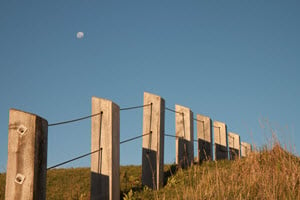Adverse Possession of Real Estate

A fence installed in the wrong place by your neighbor can lead to an adverse possession problem.
QUESTION: If you hold title to real estate by a deed or by inheritance, can you lose that ownership by a person taking possession of your property openly, notoriously, hostilely, continuously, and visibly for a period in excess of 21 years? ANSWER: Yes. In Pennsylvania, the legal concept of adverse possession has been a viable concept for many, many years. Even though you are paying taxes on real estate legally owned by you by deed or inheritance, by adverse conduct of a neighbor or a third party who is not even a neighbor, if that conduct is conducted for a period in excess of 21 years, they can legally claim the ownership of your land. Some examples:
A Farm

It is important to be aware of all use of your property.
1) A neighbor adjoining a large farm placed a playset and a garden shed on the portion of the farm which adjoined their land. They began to mow the field, and it began to look as if it was a part of the lot on which their home was built. They also stored some firewood on that portion of the farm which was adjoining their lot, planted a small garden, and continued mowing the balance of the area which immediately adjoined their lot. After 21 years they could legally claim that they owned that portion of the farm that they had been using continuously for a period of 21 years. The farmer acknowledged that he was aware that they were using his field, but he never gave them permission, and he never told them to stop. The entire time the farmer was paying taxes on the entire firm, which included the portion being used by the adjoining neighbors. After 21 years they could claim the portion of land that they were using immediately adjacent to their lot, and the farmer could do nothing to prevent it. This would have been so even if they sold the lot to somebody else and that person continued to use that portion of the farmer’s land adjoining the lot, and in fact, if it had been transferred several times and each successive owner continued to use that portion of the farmer’s land adjoining their property, after 21 years it would have belonged to the last owner in that chain of title because there is a legal theory known as “tacking”, which one person claiming adverse possession of another person’s land can tack that ownership through their successive previous owners until the 21 years is reached.
Visible Use of the Land
Even if not all of the use of the land continued as I just described it above, as long as they were making visible use of that land in some way, i.e., perhaps only mowing it or mowing it and placing firewood on it or mowing it and putting a child’s exercise equipment on it, or, perhaps, putting a gazebo or a storage shed on the land, there is no formula for how much has to be done to the land as long as it is being done in such a way that the adverse use should bring to the attention of the true owner that someone is making use of their land without their permission, and the true owner never notifies the person using their land to stop or does not give them explicit permission. The giving of permission to someone else to use the land prevents them from claiming ownership by adverse possession after 21 years.
Fencing
2) Frequently property owners want to install a fence around their property or, at least, on the boundary line between their property and an adjoining property. However, many municipal zoning ordinances require that any fence separating adjoining properties must be set a specific number of feet off of the property line on the property of the person installing the fence, typically three to five feet. If, after such fence is installed, the property owner who installed the fence never, ever goes on the other side of the fence to mow the three or five feet, to plant any shrubbery, any flowers, any bushes, etc., but the adjoining owner takes over that three to five feet, they mow it, they plant shrubbery on it, they plant a tree or flowers on it and continue to maintain it for 21 years, without the permission of the person who installed the fence, they can claim ownership of that strip of land. 3) Frequently in city properties where you have adjoining townhouses/row houses, there is a fence that is supposed to be on the property line and frequently was installed when those properties were first built which, in many cities, was actually in the late 1800s or early 1900s. If the fence was not truly installed on the property line but was installed slightly off the property line, either in a straight line or in a somewhat jigsaw line, so that a portion of the fence is on one property and a portion of the fence is on the other property, and neither party ever paid any attention to it, and now one of the parties has a survey and determines that a portion of the property which truly belonged to the neighbor is fenced on their property, and they have been maintaining it, that neighbor can claim that a portion of the other adjoining person’s property is actually being taken care of by them. Under such situations, the parties can either claim ownership, potentially, by adverse possession or what is known in Pennsylvania as a consentable boundary line, i.e., if adjoining property owners recognize a boundary line that has been in existence in excess of 21 years and have never done anything to determine whether it is really the correct boundary line based upon their deeds, that boundary line is now recognized as the true property line.
Driveways
4) A neighbor, without permission of their neighbor, begins to drive over a portion of the neighbor’s property in order to gain access to their property without ever asking for permission or receiving written permission, and the neighbor across whose property they are driving never tells them to stop using it but just ignores it and lets them continue driving across their property. At the end of 21 years the neighbor who has been driving across the adjoining property owner’s property now has what is known as an Easement by Prescription, which means that they have acquired the perpetual right to cross the neighbor’s property based upon the adverse use theory, which means they have been driving across the property without any permission of the neighbor openly, notoriously, continuously, hostilely, and visibly for a period of 21 years, unless the land is woodland surrounded by a fence which the prescriptive user cut or removed to gain access through the woods. In that event they cannot obtain a prescriptive easement unless a court would decide that the woods are not “woods” but only trees. In that situation, which actually happened to the author, the prescriptive easement was upheld by the court.
A Way to Maintain Ownership: The Rockefeller Foundation
Many persons reading this may remember or have visited the ice skating rink at Rockefeller Center in New York. The one street which adjoined the skating rink was a private street owned by the Rockefeller Foundation and its successive owners. Every year that street was blocked off for a day by the Rockefeller Foundation in order to prove that they still claimed ownership of that street and to prevent the city of New York or anyone else from claiming that the street was a public street because it had been used open, notoriously, hostilely, continuously, and visibly for a period in excess of 21 years. It is my understanding that at some time in the last several years the owners of Rockefeller Center dedicated that street to the public, and it has now become a public street.
Protect Your Property
BOTTOM LINE: If you own a piece of real estate on all or a portion of which a neighbor or other person begins to use your land by either mowing it, planting crops on it, planting flowers, a garden, trees, or installing a gazebo or what have you, it becomes imperative on your part that you provide a written notice to them, informing them either that they are trespassing and are no longer permitted on your property or advising them that you are giving them permission to use your property but they cannot obtain any ownership right through adverse possession. If you are going to give them permission to use your property, it can only be by a written document signed by all parties and recorded in the Recorder of Deeds Office of the county in which the property is located so that any subsequent owners of either your land or the adjoining land, when they are having the title searched, will ascertain that that portion of your land has been used with your permission by the adjoining owner, and it has not become a part of their real estate, and you have not lost a portion of your real estate. As an attorney who has owned a title insurance agency since 1967, who has written the only book on title searching sold through Amazon nationwide and is now in its fourth edition since 1981, and who has searched and/or examined over 18,000 titles, I can assure you that the concept of adverse possession is alive and well and that, as an attorney, I have handled a number of cases which went to litigation, by which one or the other owners were either attempting to expel the person claiming adverse possession or was attempting to claim adverse possession against the neighbor whose land they have been using in excess of 21 years.
Problems with Adverse Possession?
This is an area of the law in which the York PA law firm of Hoffmeyer & Semmelman is very well versed and stands ready to assist you if you feel that you have, or are aware that you have, this type of a problem. Contact us for help.

